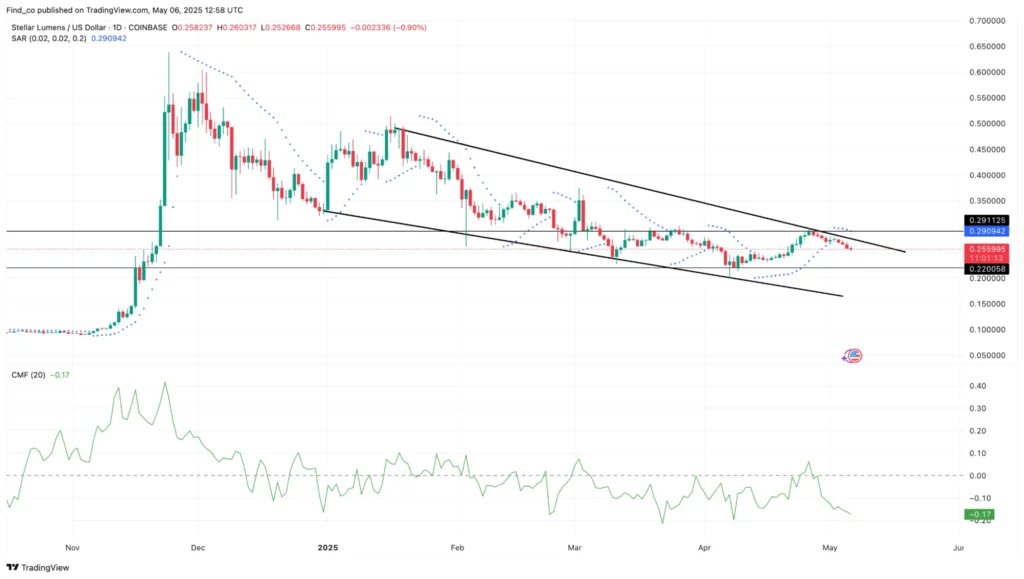- 1. Volume Declines Raise Red Flags for Stellar Bulls
- 2. Qubetics’ Real World Asset Tokenization Marketplace Could Redefine Utility
- 3. Conclusion: Is Stellar Still Worth Watching, or Is Qubetics a Better Bet?
- 4. For More Information:
After a promising close at $0.50 near the end of 2024, Stellar (XLM) entered 2025 with expectations of upward continuation. However, its recent trajectory has been anything but reassuring. The latest technical analysis reveals that XLM is now locked within a descending channel—an unmistakably bearish continuation pattern. As of this week, the price is struggling to stay above $0.25, having lost 8.86% in just the past seven days.
The Chaikin Money Flow (CMF) indicator has now fallen below the zero line, confirming a growing imbalance between sell and buy pressure. This shift signals waning interest from participants at current levels. Compounding concerns, the Parabolic SAR dots are now positioned above the XLM price on the daily chart. This technical alignment typically flags resistance rather than support, reinforcing the bearish undertone surrounding this Stellar Price Prediction.
Zooming into the 4-hour timeframe, the technical picture grows more ominous. The MACD has turned negative, and the 12 EMA has slipped beneath the 26 EMA—a textbook signal of continued downside momentum. Analysts are now closely watching the $0.22 support at the 0.236 Fibonacci level. If XLM breaches this threshold, a drop to $0.20 becomes increasingly plausible. On the flip side, any surprise rally that clears the $0.28 resistance could trigger a recovery toward $0.30, though current indicators suggest this is an uphill battle.

Volume Declines Raise Red Flags for Stellar Bulls
The latest technical warning signs surrounding Stellar are more than just chart-based speculation—they’re grounded in declining participation. As volume retreats, so too does the likelihood of a bullish reversal. While the broader market awaits cues from Bitcoin’s next directional move, Stellar appears to be losing ground in the altcoin rotation cycle. Even with its history of outperforming certain competitors during Q4 of 2024, XLM has struggled to capture meaningful buy-side momentum in Q2 2025.
A failure to reclaim critical resistance zones—particularly the $0.28–$0.30 region—could expose XLM to further retracement. While the overall structure of the market hasn’t collapsed, Stellar’s current technical posture doesn’t instill confidence. Momentum is lacking, support is fragile, and near-term upside appears capped unless broader macro or altcoin-specific catalysts emerge.
The broader takeaway? Any Stellar Price Prediction that projects immediate upside now needs to account for this evolving risk environment. Without renewed demand or favorable signals across leading indicators, further drawdowns remain a possibility—especially if Bitcoin continues to consolidate.

Qubetics’ Real World Asset Tokenization Marketplace Could Redefine Utility
In contrast to Stellar’s short-term uncertainty, Qubetics ($TICS) continues to draw increased attention due to its novel infrastructure—specifically, its Real World Asset (RWA) Tokenization Marketplace. As the first Web3 aggregator purpose-built to streamline blockchain interaction, Qubetics doesn’t just simplify the user experience; it fundamentally redefines it. By creating a decentralized ecosystem for tokenizing real-world assets—ranging from real estate and commodities to intellectual property—the platform eliminates long-standing inefficiencies found in traditional finance.
Picture a small business in Chicago looking to tokenize commercial real estate equity. Through Qubetics, they can easily onboard, convert their asset into a compliant tokenized instrument, and trade it cross-border with zero custodial overhead. Similarly, independent artists and software developers can fractionalize rights and licensing revenues on-chain without relying on intermediaries. These use cases, previously inaccessible due to complex multi-chain environments and cost barriers, are now frictionless through Qubetics.
What sets the platform apart in 2025 is not just its user-facing utility, but its enterprise-grade back-end. The integration of cross-chain liquidity routing, compliance modules, and decentralized escrow makes Qubetics one of the most technically advanced ecosystems focused on RWAs. Analysts suggest this modular infrastructure could create a standardized digital asset class for institutions while preserving access for everyday users. In a crypto landscape searching for real-world application, Qubetics may be uniquely positioned.
The ongoing narrative surrounding asset tokenization—and the lack of universal platforms capable of managing it end-to-end—is what positions Qubetics as a serious contender in discussions around the best crypto to buy in 2025.

Qubetics Presale Reaches Over 511M Tokens Sold Amid Rising ROI Forecasts
The numbers behind Qubetics are beginning to command attention. Currently in Stage 33 of its token presale, the platform has already raised over $16.7 million, with 511 million $TICS tokens sold and over 25,900 unique token holders onboarded. Each stage of the Qubetics crypto presale runs for just 7 days, and at the stroke of midnight every Sunday, the token price increases by 10%. The current price stands at $0.2302, a figure that remains undervalued in the eyes of many analysts considering the project’s potential for multi-sector adoption.
Let’s break this down with a real-world scenario. If a participant were to contribute $100 today, at $0.2302 per token, they would receive approximately 434.47 $TICS. Should Qubetics hit its post-mainnet target of $10 per token, the initial $100 allocation would rise to an impressive $4,243.26, yielding a 4,243.26% ROI. In more aggressive forecasts—where $TICS climbs to $15—the same investment would reach $6,414.90% ROI. Even conservative models projecting $1 would offer more than a 334% return.
It’s this asymmetry in potential upside that positions Qubetics as the best crypto to buy in 2025—especially when evaluated alongside short-term speculative assets. Furthermore, its growth is supported not by hype cycles, but by a robust application layer already in demand by enterprise and retail markets alike.
In a presale environment that often lacks transparency and real use case support, Qubetics is emerging as a rare outlier. That’s precisely why mentions of the Qubetics crypto presale are beginning to surface in expert analysis and comparison charts tracking next-gen altcoins.
Conclusion: Is Stellar Still Worth Watching, or Is Qubetics a Better Bet?
Both Stellar and Qubetics represent radically different moments in their respective life cycles. Stellar, a veteran in the crypto space, faces a testing period where bearish sentiment is clouding near-term potential. Technical indicators such as the CMF, MACD, and Parabolic SAR collectively suggest that downside pressure may persist unless a shift in broader market sentiment materializes.
Qubetics, by comparison, finds itself at the start of what could be a defining growth phase. With a powerful narrative around Real World Asset Tokenization, significant presale traction, and a clear roadmap leading to mainnet in Q2 2025, its proposition is compelling. It blends technical innovation with real-world demand—two pillars that often determine the longevity and scale of Web3 adoption.
As traders and community members continue to assess the best altcoins to buy and hold for short term, it’s becoming increasingly clear that Qubetics isn’t just riding a presale wave—it’s building foundational infrastructure. With its ROI potential, application use case, and positioning as a top-tier crypto presale, Qubetics currently appears more aligned with near-term growth opportunities than Stellar, especially in a market seeking renewed momentum.

For More Information:
Qubetics: https://qubetics.com
Presale: https://buy.qubetics.com
Telegram: https://t.me/qubetics
Twitter: https://x.com/qubetics
FAQs
- What is the current Stellar Price Prediction for 2025?
Given current technical weakness, the short-term outlook leans bearish, with a potential drop to $0.20 if key support levels break. A rebound would require reclaiming $0.28–$0.30 resistance levels. - What makes Qubetics a strong project to consider in 2025?
Qubetics is pioneering a Real World Asset Tokenization Marketplace that allows users to digitize and trade real-world assets seamlessly. This gives it real-world utility and scalability potential, which many other presales lack. - How much ROI can be expected from Qubetics?
Forecasts suggest that Qubetics could deliver up to 6,414.90% ROI if $TICS hits $15 post-mainnet. Even conservative outcomes could offer a return of over 334% at just $1.
This article is not intended as financial advice. Educational purposes only.










